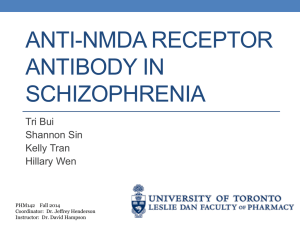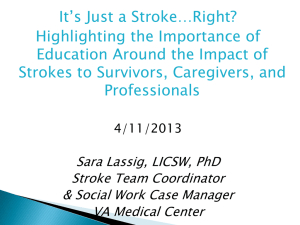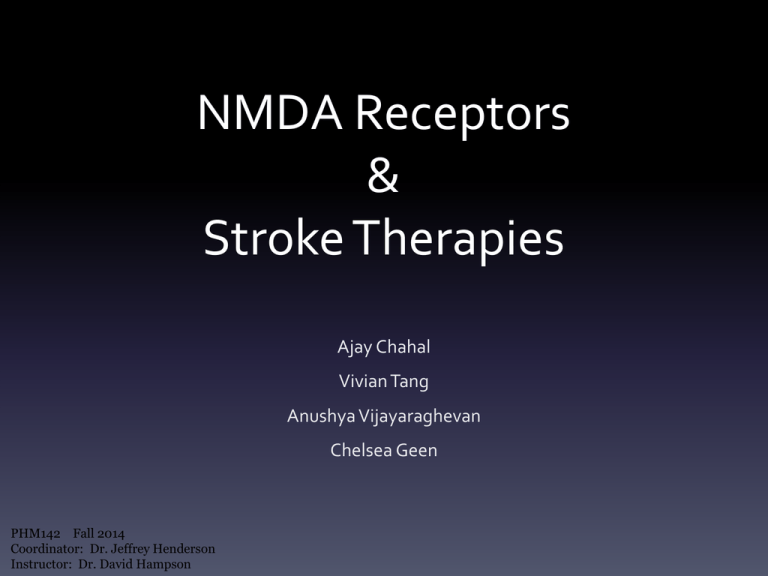
NMDA Receptors
&
Stroke Therapies
Ajay Chahal
Vivian Tang
Anushya Vijayaraghevan
Chelsea Geen
PHM142 Fall 2014
Coordinator: Dr. Jeffrey Henderson
Instructor: Dr. David Hampson
Stroke
• Caused by lack of blood flow to brain
• Variety of effects
– Partial paralysis, vision loss, dizzyness ect.
• Risk factors are:
– hypertension obesity, diabetes, excessive alcohol consumption,
smoking and stress.
(Heart and Stroke Foundation, 2014)
NMDA Receptor
• N-methyl-D-aspartate Receptor
• Found in synaptic cleft
• Glutamate-gated ion channel
– Calcium
– Sodium
• Activation: ligand binding and depolarization
(Li & Tsien, 2009)
NMDA Receptor: Mechanism of
Action
• At resting potential, the channel is blocked by a Mg2+
http://www.sumanasinc.com/webcontent/animations/content/receptors.html
(Blanke & VanDongen, 2009)
NMDA Receptor: Mechanism of
Action
glutamate
• Electrical stimulation of presynaptic neurons releases
glutamate into the synaptic cleft. The glutamate binds to
the receptor.
http://www.sumanasinc.com/webcontent/animations/content/receptors.html
(Blanke & VanDongen, 2009)
NMDA Receptor: Mechanism of
Action
• Receptor does not activate because insufficient
depolarization
http://www.sumanasinc.com/webcontent/animations/content/receptors.html
(Blanke & VanDongen, 2009)
NMDA Receptor: Mechanism of
Action
Mg2+
• During sufficient depolarization, the Mg2+ is dislodged
from channel and activates
http://www.sumanasinc.com/webcontent/animations/content/receptors.html
(Blanke & VanDongen, 2009)
NMDA Receptor: Mechanism of
Action
• Activated channel results in influx of Ca2+
Acts as a secondary messenger to activate intracellular
signaling cascade
http://www.sumanasinc.com/webcontent/animations/content/receptors.html
(Blanke & VanDongen, 2009)
Mechanism of Ischemic Cell
Death
(Bretón and Rodríguez, 2012)
Effects of High Ca2+ Concentration
in Neurons after Ischemia
Rama
(Bretón and Rodríguez, 2012)
Excitotoxic Signaling by Overstimulation of
NMDA Receptor
(Bretón and Rodríguez, 2012)
(R&D Systems, 2012)
NMDA & Stroke:
Therapeutic Attempts
Only therapy currently available:
thrombolytic recombinant tissue
plasminogen activator (rt-PA)
• give within 3 hrs
– most patients (95%) don’t receive
(eg delay to hospital)
– increases intracranial
haemorrhage risk
Image http://www.thetimes.co.uk/tto/news/uk/scotland/article3796905.ece
(Reviewed in Green and Shuaib, 2006)
Neuroprotective Agents
Another approach!
– attempt to interfere with ischaemic cascade mechanisms and
decrease tissue damage
– have been studied
• but every one to reach clinical trials…
Image http://fightingclean.com/2014/07/kevin-casey-robert-drysdale-fail-post-fight-drug-tests/
(Reviewed in Green and Shuaib, 2006)
Failed Attempts…
Table 1: Compounds that have failed clinical trials for acute ischaemic stroke treatment (Green and Shuaib,
2006).
There is still hope!
• New
neuroprotective
compounds being
investigated
– But none currently
on market
(Reviewed in Green and Shuaib, 2006)
Example: DAPK1 and NMDA
• DAPK1: death-associated protein kinase 1
– Found to be important part of neuron death signaling
cascade downstream of NMDA
– Could be a target for neuroprotective drug development!
(Reviewed in Martin and Wang, 2010)
Mechanism of Potential
Therapeutic Action
Normal synapse:
Activate NMDA receptor neuronal
survival signaling complex (SSC)
(Reviewed in Martin and Wang, 2010)
STROKE
CONDITIONS:
Increase Ca2+ influx through
NMDA receptors
activates DAPK
promotes DAPK bind and
phosphorylation of NR2B
Activated DAPK promotes
neuron death signal complex
(DSC) that shuts off SSC
Using an NR2B interference peptide
inhibit aDAPK binding to NR2B
blocks phosphorylation, decrease DSC
activation
avoid exitotoxic damage induced by
stroke!
(Reviewed in Martin and Wang, 2010)
Darth Vader = DAPK
Lightsaber = Ca2+
Darth Vader + Lightsaber = activated DAPK
Darth Vader + Lightsaber:
gives into anger (phosphorylation) and
joins the dark side (binds NR2B)
promotes neuron death signal complex
(DSC) shutting off survival signal complex
(SSC)
http://www.today.com/id/7466911/ns/today-today_entertainment/t/darth-vader-lives/#.VE8mIYvF9-g
Luke Skywalker = NR2B interference
peptide
Luke Skywalker stops Darth Vader and
his lightsaber (aDAPK) from joining the
dark side (binding NR2B), blocking Darth
Vader’s anger (phosphorylation)
Since Darth Vader is no longer angry,
death signal complex (DSC) is decreased
http://www.comicvine.com/forums/battles-7/anakin-skywalker-vs-luke-skywalker-read-op-576670/
Summary
STROKE
• Caused by an event that limits or stops blood flow to the brain
–
–
ischemia or hemorrhaging
2 kinds of ischemic stroke:
1) Thrombotic stroke: blood clot in an artery leading directly to brain
2) Embolic stroke: clot forming somewhere else in the body, travels through blood stream to the brain.
• Risk factors: hypertension, obesity, diabetes, excessive alcohol consumption, smoking and stress
NMDA RECEPTOR
• A glutamate-gated ion channel - activated when both glutamate is bound to receptor and
adequate depolarization occurs
•
•
Results in Ca2+ ion influx
NMDA receptors excessively activated resulting in increased Ca2+ influx
–
–
after ischemia, cytoplasmic Ca2+ levels rise and can trigger many downstream neurotoxic cascades
including the activation and overstimulation
the results include activation of several signalling pathways mainly causing an overproduction of free
radicals, dysfunction of mitochondria, cell membrane disruption and DNA fragmentation, which
together induce neuron death
THERAPY
• Currently only rt-PA for ischaemic stroke (within 3 hours)
• Neuroprotective agents still being investigated, although most have failed clinical trials
References
Blanke, M. L., and VanDongen, A.M.J. (2009). "Activation Mechanisms of the NMDA Receptor." Biology of the NMDA Receptor. Retrieved
from http://www.ncbi.nlm.nih.gov/books/NBK5274/.
Bretón, R.R., and Rodríguez, J.C.G. (2012). Excitotoxicity and oxidative stress in acute ischemic stroke. Stroke, 8, 9.
http://cdn.intechopen.com/pdfs/26258.pdf.
Green, A.R., and Shuaib, A. (2006). Therapeutic strategies for the treatment of stroke. Drug Discovery Today, 11:15/16.
doi:10.1016/j.drudis.2006.06.001.
Heart and Stroke Foundation. (2014). “Stroke.” Web. 27 Oct. 2014. Retrieved from
http://www.heartandstroke.com/site/c.ikIQLcMWJtE/b.3483933/.
Li, F, and Tsien J.Z. (2009). Memory and the NMDA receptors. New England Journal of Medicine, 361(3): 302-3. doi:
10.1056/NEJMcibr0902052.
Martin, H.G.S., and Wang, Y.T. (2010). Blocking the deadly effects of the NDMA receptor in stroke. Cell, 140: 174-176. DOI
10.1016/j.cell.2010.01.014.
R&D Systems. “Neuronal Death by Glutamate Excitotoxicity: Protein Mediators & Strategies for Inhibition.” (2012). Retrieved from
http://www.rndsystems.com/mini_review_detail_objectname_neuronal_death_by_glutamate_excitotoxicity_article.aspx.

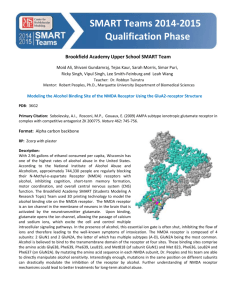
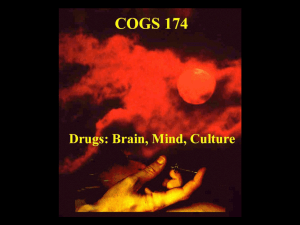



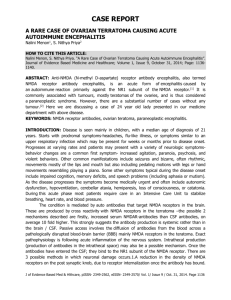

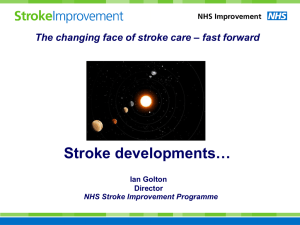
![Shark Electrosense: physiology and circuit model []](http://s2.studylib.net/store/data/005306781_1-34d5e86294a52e9275a69716495e2e51-300x300.png)

